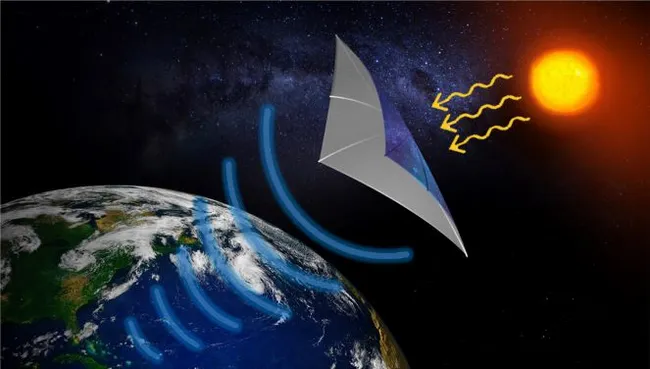
In a monumental step towards green energy, Japan has initiated a bold endeavor to harvest solar energy. It will be sent as clean, renewable electricity from space to Earth. The initiative-cum-project, OHISAMA project (meaning “sun” in Japanese), will put sunlight in orbit, turn it into microwaves, beam it to ground-based antennas, and convert it into electricity. Set to launch its first demonstration in 2025, Japan has SBSP on track to bring a revolution in clean energy production by offering a reliable, weather-independent solution to meet the total global energy needs. Hence, this article discusses OHISAMA project technology, relevance, and future capabilities to change the energy landscape.
The Vision: Solar Power from Space
In 1968, this idea was invented by U.S. engineer Peter Glaser, who envisioned that solar farms would be built in orbits around the Earth, drawing on sunlight which would not be blocked by the atmosphere of the Earth or by day-night cycles. Unlike terrestrial solar panels, obstructed by weather, cloud cover, and nighttime, a satellite-based solar collection would get sunlight 24 hours, 7 days a week, giving up to eight times more energy per square meter. The OHISAMA project at Japan Space Systems (JSS), working alongside the Japan Aerospace Exploration Agency (JAXA), turns this science fiction vision into reality. Indeed, Japan is the much-aspired global leader in research on SBSP.
The demonstration of OHISAMA will take place in 2025. This will involve a 400-pound satellite, housing a photovoltaic panel of 22-square-foot area in low Earth orbit (LEO) at an altitude of 400 kilometers. This satellite will collect the sunlight and put it into an onboard battery, followed by storage, microwave conversion, and relaying approximately 1 kilowatt of power—sufficient to run a small household appliance like a dishwasher—to a ground-based receiver in Suwa, Japan. Thus, the proof-of-concept is imperative to progress to adding gigawatt-level plants in geostationary orbit by the 2030s, at a comparable rating to a nuclear reactor in terms of output.
How It Works: Suns to Electricity
From space to Earth, the OHISAMA project uses a complex process to deliver clean energy:
- Solar Collection: A solar module installed on a satellite to provide photovoltaic panels collects sunlight in orbit, where solar energy is five times stronger than that on Earth due to the absence of atmospheric filtering.
- Energy Conversion: Then, the solar energy turns into a direct current (DC) and gets stored in a battery. Using gallium nitride semiconductor amplifiers, it will then convert electricity to microwaves for long-distance transmission.
- Microwave Transmission: The microwaves are sent down to Earth through a retrodirective antenna system using a pilot signal from the ground that provides pinpoint accuracy (0.15 degrees in ground tests). This assures that the energy beam will target the receiver station even if travelling at high speed over 28,000 km/h in orbit.
- Ground Reception: A 600-square-meter rectenna (rectifying antenna) on the ground for the 2025 demo captures the microwaves and transforms them back into DC electricity, before being converted into alternating current (AC) for the electricity grid.
It would not matter what the weather was because, unlike solar farms on land, microwaves can penetrate clouds, making it a good alternative for ground solar installations. This signifies that 80% of conversion efficiency from solar to microwave to electricity is a testament to Japan’s advancement in wireless power transmission, through milestones such as the 2015 test that sent 1.8 kilowatts over 55 meters with pinpoint accuracy.
Why Space-Based Solar Power Matters
Under the project, Japan’s OHISAMA will address critical energy challenges globally:
- Perpetual Energy Source: Compared with terrestrial solar, SBSP promises continuity of operation 24/7, unaffected by day and night cycles or inclement weather; hence a definite power supply can be assured in keeping up with increasing energy demand.
- Clean Energy Source: As unpolluting energy, SBSP will help combat global greenhouse emissions, which coincidentally aligns with all projects worldwide against climate change, and on their commonly reduced dependence by countries on fossil fuels, hence supporting Japan’s targets for carbon neutrality by 2050.
- Absence of Land Use: Solar farms built on the ground have land-size requirements that usually disturb ecosystems. With SBSP, some rectenna could be in remote places such as offshore islands or reservoirs with low environmental interference.
- Global Energy Access: SBSP power can flow into remote or disaster-stricken areas via delivery, providing that lifeline where traditional infrastructure would otherwise not exist.
That importance is enhanced because Japan has constraints on energy. Its energy post-Fukushima aims to completely seek out alternatives to nuclear power, and SBSP is so much safer and inexhaustible. Therefore, if OHISAMA succeeds, Japan may become a world leader in renewable energy, and there may be export opportunities for the technology developed.
Challenges Ahead: Safety Issues
However promising the OHISAMA project might be, it is scuffed by technical and logistical props:
- High Costs: Putting satellites into space and blowing large offensive systems into orbit costs a lot of money. Even with the reusable rockets from SpaceX, a solar farm of 1 gigawatt would have to cover 2 kilometers on each side with panels, not a small amount of money or engineering all on its own.
- Transmission Efficiency: These losses happen in microwave transmission. Current tests show losses, but JAXA (Japan Aerospace Exploration Agency)hopes to improve this efficiency with a new approach using advanced retrodirective systems.
- Space Debris and Durability: Effectiveness against micrometeoroids, solar flares, as well as radiation at the level of required durability for all satellites, suppressing damage to components by their respective ages.
- Public Perception: Concerns revolve around microwave safety but also extend to wildlife or humans, which some believe will be harmed by it. According to JAXA(Japan Aerospace Exploration Agency), the energy density of the beam is equal to that of sunlight and definitely lower than that of ionizing radiation; there are both rapid cut-off systems for reducing risk included in the system.
Thus, Japan will conduct extensive ground tests, which include an aircraft transmission planned for December 2025, and create low-cost methods such as robotic assembly and modular designs.
Comparison: OHISAMA vs. Terrestrial Solar
| Feature | OHISAMA (SBSP) | Terrestrial Solar |
| Availability of Energy | 24/7, independent of weather | Limited by day-night cycles, weather |
| Energy Yield | 5–8× higher per m² | Lower because of atmospheric filtering |
| Land Use | Negligible (rectennas sited in remote areas) | Large land areas needed |
| Initial Cost | High (launch, infrastructure) | Lower (established technology) |
| Environmental Impact | Low (no emissions, minimal land use) | Moderate (land use, ecosystem disruption) |
| Scalability | Very High (gigawatt potential) | Limited by land and weather |
Global Context and Competition
Japan is not alone in pursuing SBSP. The U.S. (Caltech’s MAPLE project) did indeed transmit power from space in 2023, while China plans to start construction on a 200-ton SBSP station by 2035. Not only does the European Space Agency work on SBSP under their Solaris program, whose activities are reinforced by other initiatives in the U.K., but OHISAMA will be the first to take an end-to-end SBSP demonstration in 2025. The Japanese project will capitalize on decades of effort, which include breakthroughs like the 10-kilowatt transmission by Mitsubishi in 2015.
Future Prospects: World-Powered by the Sun?
An OHISAMA test for pilot plants could lead to commercially deployed SBSP systems within the next decades. JAXA envisages a 1 GWe disaggregated orbital solar farm in geostationary orbit (36,000 km), possibly powering cities and replacing energy dependence on fossil fuels to help meet global sustainability goals. Reflected excitement on X posts might be called a “step toward a Dyson Swarm” or a “game-changer for clean energy.”
In the long run, SBSP would help foster space exploration with lunar bases or Mars missions powered by the technology, according to Caltech researchers. Japan’s modular, sandwich-sized, pizza-box-sized panels promise cost savings through robotic assembly, thus allowing SBSP to become economically feasible.
Conclusion
On the one hand, Japan’s OHISAMA project will beam solar power from space in 2025, boldly making a step toward the clean energy future. By capturing sunlight in orbit and transferring that energy through conversion into microwave radiation down to rectennas on the ground, the project seeks to make up for terrestrial solar power’s deficiencies. While it will face challenges related to cost and public perception, Japan’s decades of investment in research and development excellence should position it most prominently at the leading edge of the SBSP revolution. In the eyes of an enthralled world, OHISAMA could rewrite the story of how we power our planet—placing the world in a new sustainable energy paradigm, available 24 hours over the generations to come.






